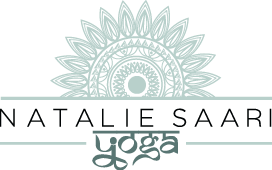WHAT IS YOGA THERAPY?
Yoga therapy is the application of yoga for therapeutic purposes; A type of therapy that uses yoga postures, breathing exercises, meditation and guided imagery to improve health. It is also a holistic approach, integration of mind and body. Modern yoga therapy encompasses a broad range of therapeutic modalities, incorporating elements from both physical therapy and psychotherapy used to aid a wide range of physical and mental conditions.
WORKING WITH A YOGA THERAPIST
Natalie Saari is a yoga therapist registered through the International Associated of Yoga Therapy (IAYT), the world-renowned governing body of yoga therapy. IAYT supports research and education in yoga and serves as a professional organization for yoga teachers and yoga therapists worldwide.
Yoga therapy is a growing field with more and more scientific evidence demonstrating its efficacy. It is used to treat various health issues, as a self-care tool for prevention and maintenance. Because of its concentration on mind and body integration, yoga therapy is also used to address many physical health issues. It has been effectively used to treat back pain, heart and respiratory conditions, asthma, chronic fatigue, hypertension, multiple sclerosis, and side effects of chemotherapy. It is also a well established treatment for depression, anxiety and post-traumatic stress disorder (PTSD). Additionally, yoga therapy is now being used as a treatment modality for children with autism.
Working with a yoga therapist, the goal is to assess and manage health risk, promote lasting health behaviour change, and enhance quality of life. Education is provided about the body, lifestyle and tools for self-care. Detailed instruction of alignment is provided to ensure the individual can practice safety and effectively on their own.
BENEFITS OF YOGA THERAPY
Yoga therapy is practiced in a wide range of formats. Physical therapists, for example, often implement yoga techniques in their delivery of exercise programs. Yoga therapy practice can resemble physical therapy, rehabilitative therapy, and/or psychotherapy. Unlike a standard yoga class, yoga therapy sessions are typically conducted in one-on-one or small group settings. Yoga therapy can be provided as an adjunct therapy to complement other forms of treatment, or it can be used to directly treat a specific issue. Yoga techniques range from simple to advanced, and can be enjoyed by people of all ages and abilities. Potential benefits from yoga therapy include increased physical fitness, pain reduction, stress reduction, psychological well-being, efficient functioning of bodily systems and more.
WHAT TO EXPECT FROM YOGA THERAPY
Once the assessment and treatment plan have been completed, therapy sessions will most likely include the following components:
Breathing Exercises (Prayanama): The therapist will guide the individual through a series of breathing exercises ranging from energizing breaths to balancing breaths.
Physical Postures (Asana): The therapist will teach the individual appropriate yoga poses that address problem areas.
Meditation (Dhyana): Relaxation and mindfulness are the focus of meditation.
Guided Imagery: The yoga therapist attempts to calm the body and mind by providing a guided visualization intended to bring inner peace.
Home Practice: An important element for any yoga practice is to find a way to incorporate it into daily life. The yoga therapist provide provide instruction and tools on how to use what has been learned in treatment at home.
For more information, visit: International Associated of Yoga Therapy (IAYT)



